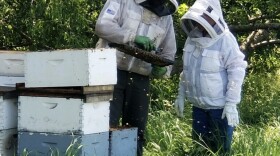Hello, Radio Readers. This is Valerie Brown-Kuchera, talking to you again from Quinter. I’m introducing our final selection, Edible Stories by Mark Kurlansky. You might recognize the author because he’s also responsible for the Federal Writers’ Project collection The Food of a Younger Land, which was our first book in Food and Story.
Edible Stories is much different from The Food of a Younger Land for several reasons. It’s fiction. Kurlansky usually serves up non-fiction. Also, this is all by him; it’s not a compilation of essays by other authors. The Food of a Younger Land seems more along the lines of Kurlansky’s other pieces of respected food history, such as Salt: A World History and Cod: A Biography of the Fish that Changed the World.
The subtitle of Edible Stories is “A Novel in Sixteen Parts,” but I’m struggling to view this as a novel at all. It certainly doesn’t have the kind of structure readers expect from a novel. I’d call it more of a potluck of stories that share a few key ingredients – characters, props (notably the Hawaiian red sea salt), and locales. In places, the connection between the stories is quite tenuous. As I was reading, sometimes I didn’t even recognize the character connection in one story until the very end of that particular piece or maybe not even until I was midway through another story, when I would have an “aha” moment.
I was reminded of the silly “six degrees of Kevin Bacon” game. You know, the challenge to link any actor back to Kevin Bacon in six or fewer steps by connecting them through their movie roles? If you’re not familiar with this game, it is based on the idea that any two people on earth are six or fewer acquaintance links apart. I found myself doing the “six degrees of separation of Robert Eggle” with characters in this book as I was reading. Instead of a Bacon number, characters got an Eggle number. So Margaret got an Eggle number of one because she was actually in a story with Eggle. But Joe, who was the man contemplating eating Margaret in the last story, got an Eggle number of two, because he wasn’t in a story with Robert, but he appeared in one with a character who was. I know, I know. It’s a bit ridiculous, but I am easily entertained! While I am being ridiculous though, I’m just going to say that I find it a funny coincidence that the game is called “six degrees of Kevin BACON!” So we have the Bacon and Eggle game! Okay, okay. I’ll stop. But I do plan to bring up the interesting names in this book in a later Book Byte, so be prepared for more silliness!
As we get into our final selection, I think we’ll need to keep the unique structure in mind, and view Edible Stories as the potluck that I mentioned earlier. Here on the High Plains, when we go to a potluck, we expect some things to be a little off. We may find a tator-tot casserole next to a ‘Nilla wafer pudding, next to a ramen noodle salad, next to a bag of chips that the guy who forgot about the event picked up at the quick store on his way there. Hopefully, as we progress, we can divvy out a little of this and a little of that, and not get too caught up in whether or not logical plot format is followed. I’m looking forward to hearing your insights and ideas in the coming weeks as we wrap up the leftovers in our Food and Story theme.





